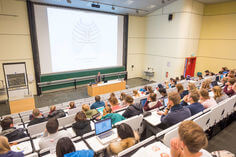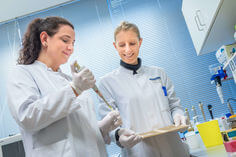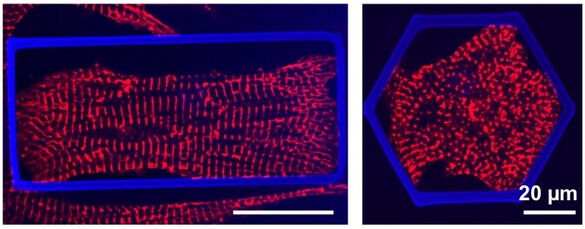- Institut
-
Herz- und Kreislaufphysiologie
- Markus Hecker
- Thomas Korff
-
Hugo H. Marti
-
Forschung
- Zelluläre und molekulare Mechanismen der postnatalen Entwicklung des zerebralen Gefäßsystems
- Die Bedeutung der molekularen PHD-HIF Achse für den akuten Schutz und die langfristige Regeneration nach einem ischämischen Schlaganfall
- Charakterisierung und gezielte Aktivierung von NRF2-abhängigen antioxidativen Mechanismen beim akuten Schlaganfall
- Extrazelluläre Nukleinsäuren als Trigger neuroinflammatorischer Prozesse in akuten und chronisch degenerativen Erkrankungen des Zentralnervensystems
- Neuroprotektion und Neurogenese
- Blut-Hirn-Schranke
- Publikationen
- Personal
-
Forschung
- Andreas H. Wagner
- Neuro- und Sinnesphysiologie
- Lehre
- Zentrale Einrichtungen
- Bernard Katz Lecture
- Stellenangebote
- Aktuelles
Shaping the Heart – Structural and Functional Characteri-zation of Stem Cell-Derived Cardiomyocytes (SC-CMs)
The adult mammalian cardiomyocyte is a highly specialized and terminally differentiated cell with distinct structural features.
A precise microarchitecture, e.g. a regular transverse (t)-tubular network (A) and strict myofilament organization, is a prerequisite for the sophisticated functional specialization of heart cells and provides the basis for local calcium signaling domains and protein interaction clusters for efficient excitation-contraction (EC-) coupling. Lack of this microarchitecture in premature SC-CMs (B) strongly limits the efficiency of cell contraction and force production.
Comparison of murine adult ventricular cardiomyocytes (A) and induced pluripotent stem cell-derived cardiomyocytes (iPSC-CMs, B). Membrane-specific stainings reveal clear differences in the structural organization of both cardiomyocytes. The membrane-specific indicator di-8-anepps was used to mark the sarcolemma. The rectangular shape and regularly spaced transverse (t)-tubular membrane invaginations (see insert) are characteristic for adult cardiomyocytes, while IPSC-CMs do not present any specific cell geometry or regular t-tubular network.
These deficits may be overcome by triggering cellular maturation through optimized in vitro culture conditions, aiming at better mirroring the in vivo situation. In this project, we test the hypothesis that a specific cell geometry influences the subcellular microarchitecture of SC-CMs with the aim to trigger morphological and functional maturation in these cells and to approach a similar phenotype as mature myocytes. In a multi-disciplinary approach combining the expertise in material science and bio-engineering with cardiac cell physiology, we analyze the effects of material contact and specific predefined geometries on cell shape and function at the level of single cells.
Different geometries induce structural remodeling in SC-CMs. α-actinin staining reveals the organisation of the contractile apparatus.
This project is part of the research bridge “Synthetic Biology” established by HEiKA, and a collaboration with the lab of Prof. Dr. Martin Bastmeyer at the Karlsruhe Institute of Technology.
- Institut
-
Herz- und Kreislaufphysiologie
- Markus Hecker
- Thomas Korff
-
Hugo H. Marti
-
Forschung
- Zelluläre und molekulare Mechanismen der postnatalen Entwicklung des zerebralen Gefäßsystems
- Die Bedeutung der molekularen PHD-HIF Achse für den akuten Schutz und die langfristige Regeneration nach einem ischämischen Schlaganfall
- Charakterisierung und gezielte Aktivierung von NRF2-abhängigen antioxidativen Mechanismen beim akuten Schlaganfall
- Extrazelluläre Nukleinsäuren als Trigger neuroinflammatorischer Prozesse in akuten und chronisch degenerativen Erkrankungen des Zentralnervensystems
- Neuroprotektion und Neurogenese
- Blut-Hirn-Schranke
- Publikationen
- Personal
-
Forschung
- Andreas H. Wagner
- Neuro- und Sinnesphysiologie
- Lehre
- Zentrale Einrichtungen
- Bernard Katz Lecture
- Stellenangebote
- Aktuelles






